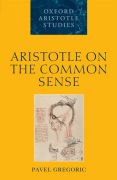
Pavel Gregoric presents a detailed investigation into the Aristotelian concept of the common sense, which explains complex perceptual operations that cannot be explained in terms of the five senses taken individually. Such operations include perceiving that the same object is white and sweet, or knowing that one's senses are inactive. Apart from using our eyes to see and our ears to hear, we regularly and effortlessly perform a number of complex perceptual operations that cannot be explained in terms of the five senses taken individually.Such operations include, for example, perceiving that the same object is white and sweet, noticing the difference between white and sweet, or knowing that one's senses are active. Observing that lower animals must be able to perform such operations, and being unprepared toascribe any share in rationality to them, Aristotle explained such operationswith reference to a higher-order perceptual capacity which unites and monitors the five senses. This capacity is known as the 'common sense' or sensus communis. Unfortunately, Aristotle provides only scattered and opaquereferences to this capacity. It is hardly surprising, therefore, that the exact nature and functions of this capacity have been a matter of perennial controversy.Pavel Gregoric offers and extensive and compelling treatment of the Aristotelian conception of the common sense, which has become part and parcel of Western psychological theories from antiquity through to the Middle Ages, and well into the early modern period. Aristotle on the Common Sense begins with an introduction to Aristotle's theory of perception and sets up a conceptual framework for the interpretation of textual evidence. In addition to analysing those passages which makeexplicit mention of the common sense, and drawing out the implications for Aristotle's terminology, Gregoric provides a detailed examination of each function of this Aristotelian faculty. INDICE: Preface Abbreviations Introduction Part I: The Framework Aristotle's project and method The perceptual capacity of the soul The sensory apparatus The common sense and the related capacities Part II: The Terminology Overlooked occurrences of the phrase 'common sense' De Anima III.1 425a27 De PartibusAnimalium IV.10 686a31 De Memoria et Reminiscentia 1 450a10 De Anima III.7 431b5 Conclusions on the terminology Part III: Functions of the common sense Simultaneous perception and cross-modal binding Perceptual discrimination Waking,sleep, and control of the senses Perceiving that we see and hear, and monitoring of the senses Other roles of the common sense Conclusion Appendix Bibliography General Index Index of Passages
- ISBN: 978-0-19-964009-6
- Editorial: Oxford University
- Encuadernacion: Rústica
- Páginas: 266
- Fecha Publicación: 01/12/2011
- Nº Volúmenes: 1
- Idioma: Inglés
